


 Before the development of an effective vaccine, policymakers had to use other approaches such as mask mandates and stay-at-home orders to slow the spread of COVID-19. In new research covering 164 countries, Brian An, Simon Porcher, Shui-Yan Tang, and Eunji Emily Kim examine the effectiveness of these measures aimed at stopping the spread of COVID-19, finding that mask mandates, if adopted early, were the most effective. They also find that countries with less individualistic cultures, and those with better healthcare capacity prior to the pandemic, were more likely to adopt early mask mandates.
Before the development of an effective vaccine, policymakers had to use other approaches such as mask mandates and stay-at-home orders to slow the spread of COVID-19. In new research covering 164 countries, Brian An, Simon Porcher, Shui-Yan Tang, and Eunji Emily Kim examine the effectiveness of these measures aimed at stopping the spread of COVID-19, finding that mask mandates, if adopted early, were the most effective. They also find that countries with less individualistic cultures, and those with better healthcare capacity prior to the pandemic, were more likely to adopt early mask mandates.
Before the widespread availability of effective vaccines, the only viable approach to slow the spread of SARS-CoV-2 (COVID-19) was to use government-imposed non-pharmaceutical mandates such as social distancing, mandatory mask-wearing, mass gathering bans, stay-at-home orders, and closures of schools and businesses. Despite their demonstrated effectiveness, many government mandates can hurt the economy and other aspects of social and personal wellbeing.
Suppose mask-wearing mandates are more effective than other measures in both the short- and long-run. If it is imposed shortly after the initial outbreak, it may be unnecessary to mandate more drastic measures such as domestic lockdowns and business closures. However, as shown in Figure 1, many governments chose the reverse strategy during the first global wave of the pandemic due to a lack of scientific knowledge, guidelines from international and national health institutions, and different cultural and behavioral orientations, among other factors.
Figure 1 – Worldwide Adoptions by Mandate Type over Time
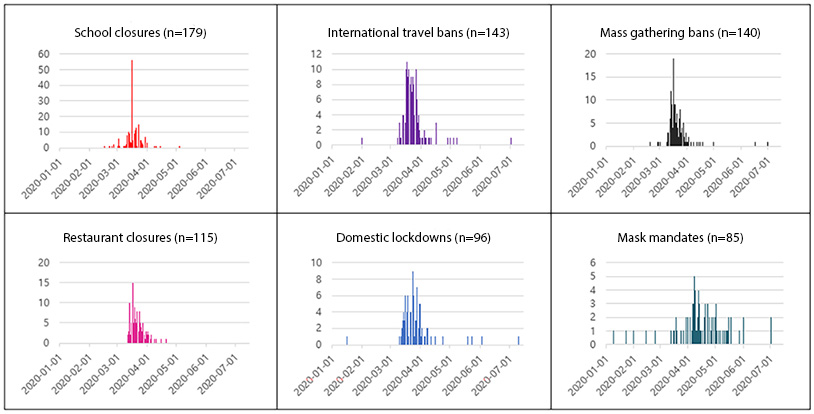
Notes: The figure presents the frequency of adoption of each mandate at the national scale by n countries over time during the first wave of COVID-19 pandemic. The scales of the y-axis are all different. Data on mandates are from Porcher, S. “Response2covid19, a dataset of governments’ responses to COVID-19 all around the world.” Sci Data 7, 423 (2020). The version used in the paper is the V5 covering the first wave of COVID-19 and is accessible on Open ICPSR.
Medical research has shown that transmission rates among asymptomatic and pre-symptomatic groups may be as significant as those among symptomatic patients. Moreover, COVID-19 transmission rates vary across age groups. For example, epidemiological data and simulation models indicate lower transmissibility among children than adults. If so, early school closures alone may have less effect in controlling infection spread than other restrictive measures targeting adults. While these factors complicate government strategies for virus containment, early adoption may still be crucial for a mandate to attain most gains.
How did different policy mandates effect COVID-19 infection rates?
Our analysis of worldwide data during the first wave of the COVID-19 pandemic (January 1 to July 15, 2020) reveals the short-term efficacies of different policy mandates in reducing infection rates (Figure 2). First, only two mandates show consistently significant relationships over all time lags between 5 and 21 days: mask mandates and mass gathering bans. Second, domestic lockdowns and restaurant closures do not seem to help contain virus transmission in the short term, showing no significant relationship until 30 days. Lastly, while mask mandates’ efficacy appears immediately and then decreases consistently over time as one might expect, mass gathering bans and school closures show otherwise; their influence seemingly needs more time to materialize.
Figure 2 – Short-term Efficacy of Mandate Adoption on the Rate of New Cases
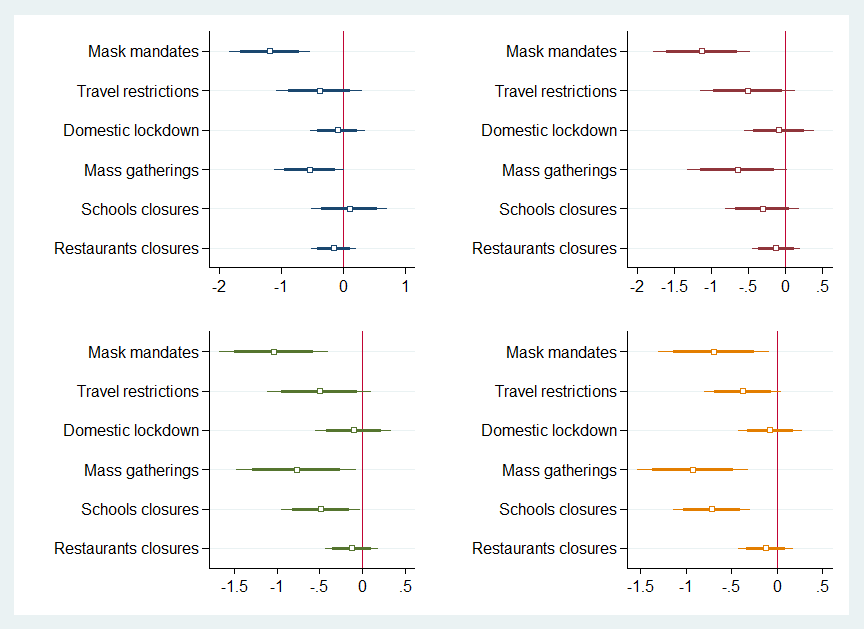
Notes: n=21,126~21,155 country-day pairs, covering 164 countries in all models. This table summarizes the associations between policy mandates and the rate of new cases – measured as the ratio of new cases to total cases in percent – after controlling for other variables. Each color represents a different lag for the policy mandates (blue: 5 days, red: 9 days, green: 12 days, and orange: 21 days). Fixed-effects regression for panel data used for estimation. Robust standard errors clustered by subcontinents. Within R-squared is between 0.86 and 0.87. 95% (bold) and 99% (thin) confidence intervals are reported around the coefficient. Full results can be found at https://doi.org/10.1111/puar.13426.
Figure 3 shows how policy mandates also differ in their long-term effectiveness. Countries mandating mask-wearing within two weeks of the first COVID-19 infection had lower rates of total infections between the 90th and 120th day than those that did not. Interestingly, among six policy instruments, only the mask mandate retains strong significance in the association with total infection rates in later days. The effect of the mask mandate shown in Figure 3 is substantial as its one-unit increase translates to a 0.45 standard deviation of lower infection rate in the 129 sample countries.
Figure 3 – Long-run Efficacy of Early Mandate Adoption (Cross-sectional Analysis)
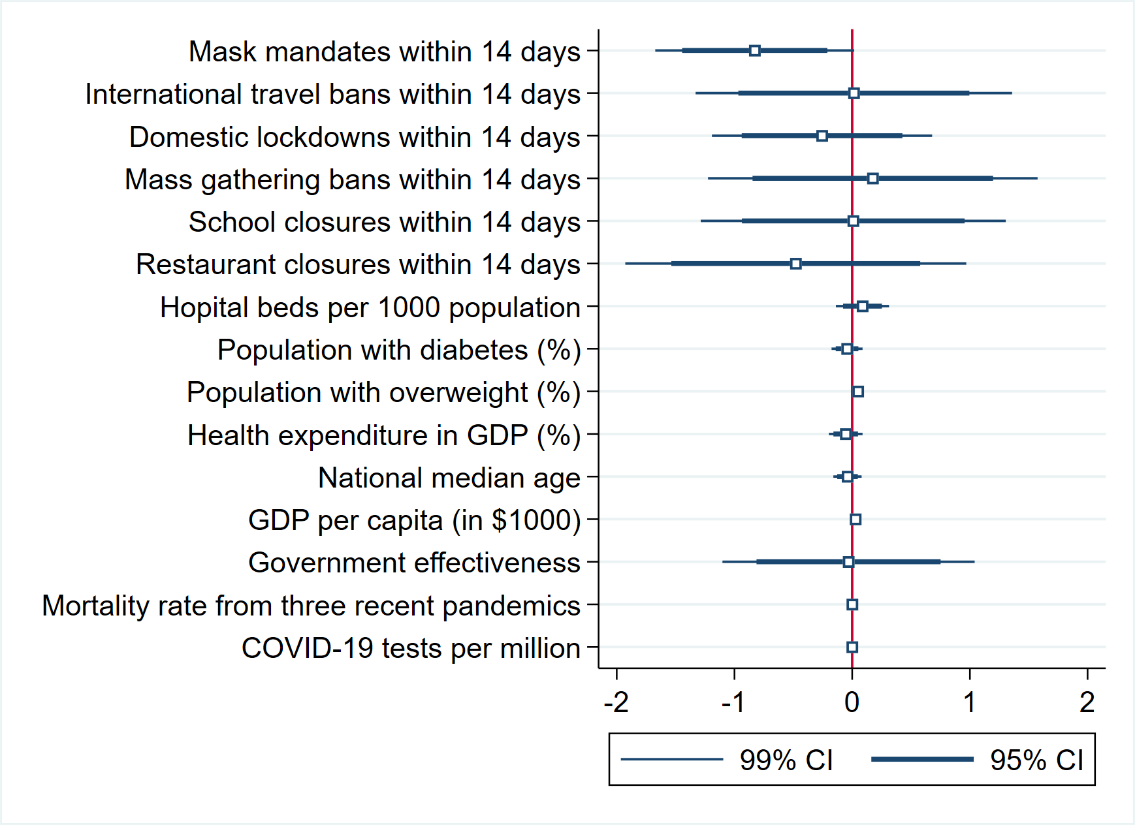
Notes: N=129 countries. Estimates represent the predicted infection rate change between the 90th and 120th days (log of total infections per million) by one unit increase of the variables. Each mandate was coded in three scales: 0 (no adoption), 0.5 (partial/regional adoption), and 1 (strict/nationwide adoption). Whether they were ever mandated during the study period was controlled but not shown here. Five continents-fixed effects are also included but not reported here. Robust standard errors clustered by 19 subcontinents. R-squared is 0.64 and adjusted R-squared is 0.56. Full results can be found at https://doi.org/10.1111/puar.13426.
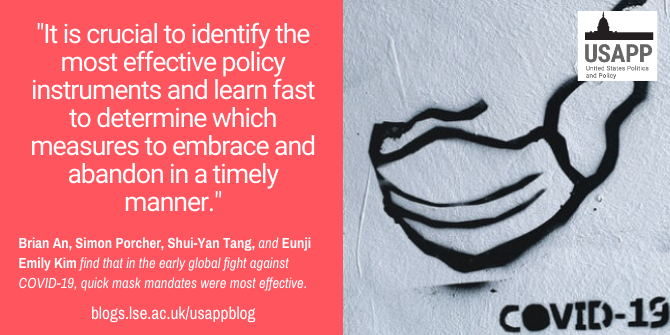 Photo by Adam Nieścioruk on Unsplash
Photo by Adam Nieścioruk on Unsplash
Why some countries acted faster than others
Why were some countries quicker to adopt the mask mandate, benefiting subsequently from its highest efficacy relative to other policy choices? Most of the usual predictors—electoral democracy, government effectiveness, prior pandemic experience, and general public health risk factors—do not meaningfully predict the pace of nationwide mask mandate adoption (Figure 4). The two most significant predictors are collectivist culture (where group needs outweigh those of individuals) and the number of hospital beds per population. Governments prepared for a public health crisis with stronger resilience or capacity—as measured by hospital beds per population—were quicker to adopt nationwide mask mandates. Moreover, governments with stronger collectivist cultures were quicker to adopt mask mandates, highlighting how the interaction between national culture and government’s policy instrument choice affects its endurability and effectiveness.
Figure 4 – Predictors of Early Mask Mandate Adoption (Ordered Logistic Regression)
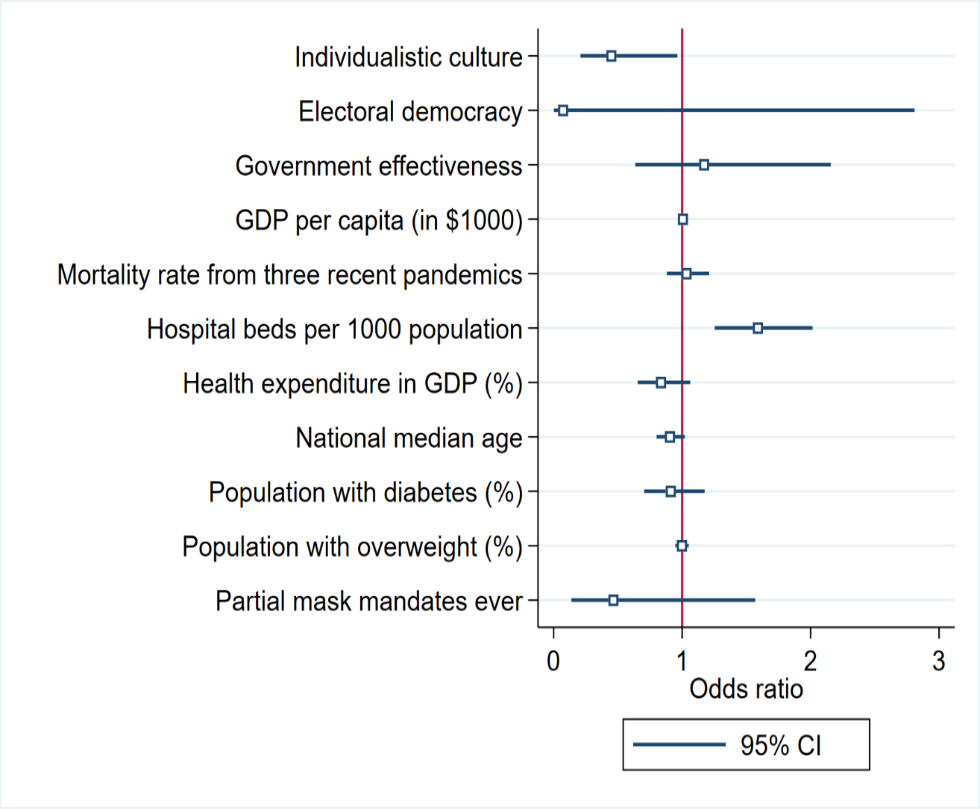
Notes: N=89 countries. The sample size is smaller than the previous cross-country analysis because Hofstede’s individualistic culture variable is available for fewer countries. The dependent variable is quartile-based ordinal coding from the distribution on days taken for mask mandate adoption at the national level, coded 0 (no adoption), 1 (4th quartile), 2, (3rd quartile), 3 (2nd quartile), and 4 (1st quartile). Five continents-fixed effects included but not reported here. Robust standard errors clustered by 19 subcontinents. Pseudo R-squared is 0.18 for the reported model. Coefficients and 95% confidence intervals reported in odds ratio. Full results can be found at https://doi.org/10.1111/puar.13426.
Many of the countries ranking high on individualism are found in Europe and North America, including Belgium, Iceland, Ireland, Italy, Luxembourg, the Netherlands, Switzerland, Sweden, the United Kingdom, and the United States. These countries have a stronger individualist culture, and they did not mandate nationwide mask-wearing regulations during the study period. Not coincidentally, their infection rates were much higher than the world average. Many of the countries ranking low on individualism (i.e., high on collectivism) are in other parts of the world, including China, Indonesia, South Korea, Thailand, and Vietnam in Asia, Venezuela in South America, and Burkina Faso and Mozambique in Africa. These nations adopted mask mandates earlier than most Western countries, and their later infection rates were all below the world average during our study period.
Many governments appear to have not picked the most efficacious set of policy instruments against the virus. The mask mandate was the least frequently adopted policy instrument among the six we examined. Many governments were significantly late in adopting the mask mandate, compared to other instruments, suggesting inadequate speed in their responses. These findings lead us to wonder whether the world would have looked differently had more governments taken the reverse strategy—mandating mask-wearing regulation early on, along with mass gathering bans and school closures, instead of relying on more socially and economically costly, yet less effective measures such as domestic lockdowns and restaurant closures. The insufficiency in instrument choice and speed can be partly explained by a lack of scientific understanding about the virus itself and differentiated effects of various policy instruments during the early phase of the pandemic.
The importance of speeding up the COVID-19 learning curve
The insufficiency can also be partly explained by the significant uncertainties around both the policy problem itself and relevant instrument effectiveness. Consistent with the policy design literature, the global responses of governments during the early phase of the pandemic reveal that policymakers tended to choose measures that were 1) more stringent and coercive, 2) more short-run and targeted, and 3) that their populations were more ideologically and culturally receptive to. Yet they must be aware of the tradeoffs between resource-intensiveness, political risks, and the public’s compliance. As the COVID-19 pandemic persists with the emergence of virus variants, policymakers and researchers must assess which policy instruments and strategies are most effective and how best to speed up the learning curve. It is crucial to identify the most effective policy instruments and learn fast to determine which measures to embrace and abandon in a timely manner.
- This article is based on the paper, ‘Policy Design for COVID-19: Worldwide Evidence on the Efficacies of Early Mask Mandates and Other Policy Interventions’ in Public Administration Review.
Please read our comments policy before commenting
Note: This article gives the views of the authors, and not the position of USAPP– American Politics and Policy, nor of the London School of Economics.
Shortened URL for this post: https://bit.ly/3Dw2uxN
About the authors
 Brian Y. An – Georgia Institute of Technology
Brian Y. An – Georgia Institute of Technology
Brian Y. An, PhD, is an assistant professor in the School of Public Policy at the Georgia Institute of Technology. His research examines how governance design and institutional choice affect policy and management processes and outcomes at all levels, from local and regional organizations to national governments across the globe. At Georgia Tech, he leads the Urban Research Group. He also co-leads the Pandemic Governance Research Group—a multi-institution and international team.
 Simon Porcher – Université Paris I Panthéon-Sorbonne
Simon Porcher – Université Paris I Panthéon-Sorbonne
Simon Porcher, PhD, is an associate professor of management and scientific director of the Chair on Public-Private Partnerships at IAE Paris – Sorbonne Business School, Université Paris I Panthéon-Sorbonne, France. He is the creator of Response2covid19, a worldwide tracker of governments’ responses to face COVID 19. His research has been published in the Journal of Public Administration Research and Theory and the Public Administration Review.
 Shui-Yan Tang – University of Southern California
Shui-Yan Tang – University of Southern California
Shui-Yan Tang, PhD, is the Frances R. and John J. Duggan Professor in Public Administration and Chair of the Department of Governance and Management in the Sol Price School of Public Policy at the University of Southern California. His research focuses on institutional analysis and design, collaborative governance, common-pool resources, and environmental politics and policy.
 Eunji Emily Kim – Georgia Institute of Technology
Eunji Emily Kim – Georgia Institute of Technology
Eunji Emily Kim, MA, is a PhD student in the School of Public Policy at the Georgia Institute of Technology. Her primary research interests lie in international technology competition and its impact on technological innovation. She received her master’s degree in international relations at Seoul National University in South Korea. Prior to joining a PhD program at Georgia Tech, she worked as a researcher at the Korea Institute of Science and Technology Evaluation and Planning.




